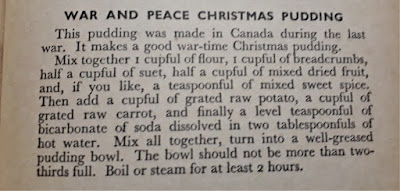The second in our blog posts of the Christmas experience during WWII
The 'Kitchen Front'
Christmas puddings in wartime
(this is the first of an occasional series of blogposts on wartime cookery and recipes)
 |
| Image from Food Facts for the Kitchen Front: A Book of Wartime Recipes and Hints (1940) |
Christmas 1940 – exactly eighty years ago - was the first Christmas under rationing since 1918. Introduced in January 1940, food rationing was largely supported throughout the war, but it posed a number of challenges for household cooking, perhaps especially at Christmastime, when the rationing of basic goods such as cooking fats, sugar and eggs, and the shortage of luxury goods such as dried fruit, made traditional Christmas recipes impossible to follow. In fact, the 8 oz sugar ration per person per week would probably seem quite generous to us now; while the replacement of eggs in the shops by dried egg powder (one packet, equivalent to 12 eggs, per person per month) was likely barely noticed in rural areas like Aberystwyth where eggs were much more easy to come by. The bare 4-6 oz of cooking fat per person per week (to include lard, margarine AND butter) was much more difficult to live with.
The government – specifically, the Ministry of Food, led by Lord Woolton – went out of its way during the war to help people cope with food rationing by producing a range of advice materials, including ‘Food Facts’ printed in newspapers or made into short films for the cinema; touring cookery demonstrations; wartime cookbooks; and an early-morning BBC radio programme The Kitchen Front. The recipe for Christmas pudding above comes from Food Facts for the Kitchen Front: A Book of Wartime Recipes and Hints, published in 1940, and so is probably one of the first wartime recipes published specifically for Christmas.
The recipe itself is a classic example of wartime ‘making-do’ with what’s available. The flour (in short supply since submarine warfare disrupted wheat imports) is bulked up with breadcrumbs (ie leftovers) and grated potatoes (home-grown). The proportion of dried fruit (again, imported) is supplemented by grated carrot (homegrown, and adding sweetness – no sugar in this pudding!). Bicarbonate of soda, not eggs, provide the raising agent, and mixed spice adds a Christmassy flavour. There are no fancy additions like lemon or orange peel (both almost unobtainable in wartime). There’s also no brandy, which seems a shame, though I guess the Ministry of Food could not be seen to be promoting alcohol, even in Christmas recipes.
For anyone wishing to try this recipe, a cupful is just that – a regular teacup size (not a mug). Interestingly, the recipe assumes the cook will know how to boil a pudding - for those (like me) who never learned, place a disc of baking paper on top of the pudding in the basin, then another big sheet of baking paper over the top, with a pleat in the centre to allow for expansion. Then either wrap in a muslin cloth (or teacloth), tying up the top with string (this is more traditional), or cover the basin with a further layer of aluminium foil (also pleated) and secure with string. Place in either a steamer or a pan with simmering water that reaches 2/3 up the side of the basin (keep the water topped up as it cooks!)
I’m going to try to cook it over Christmas and report back, and we would love to hear from anyone else willing to give it a go. The recipe can be brightened up with additional spices, nuts, etc - or of course brandy - without losing its basic authenticity (even in wartime people had storecupboards!), and can of course be made with vegetarian suet if you prefer. Nadolig Llawen!
Sian Nicholas




